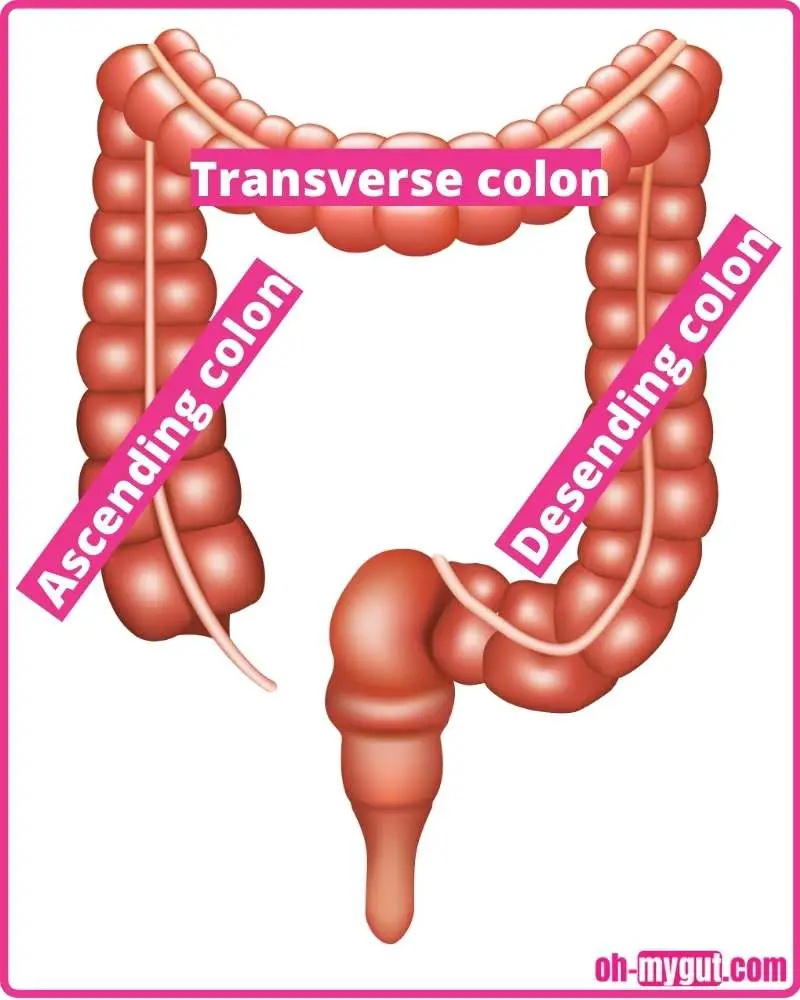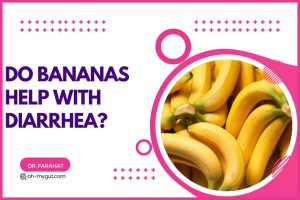Quick Insights:
- The ascending colon causes pain in the upper or lower right abdomen, which may be referred to as the right-back.
- The most common causes are infections (gastroenteritis), irritable bowel syndrome, and IBD.
- The ascending colon pain is colicky in nature (waves of contractions followed by relaxation).
- Other organs and muscles on the right side of your abdomen can cause pain similar to the ascending colon pain.
- Most commonly: Biliary pain, appendix pain, female reproductive system, and right kidney pain.
Where is the ascending colon pain located?
Your colon is a part of the digestive tract, it consists of 3 parts (ref):
- Ascending colon: Starts at the Right lower part of your abdomen, and runs upwards ending at the Right colon flexure (hepatic flexure).
- Transverse colon: Runs horizontally from the right to the left of the upper part of your abdomen.
- Descending colon: It descends on the left side of your abdomen.
- Sigmoid colon: the last part of your colon. It lies in the lower left part of your abdomen and pelvis, connecting the descending colon with the rectum.
Regarding the ascending colon pain, it is usually located on the right side of your abdomen.
It may cause pain in the upper right part of your abdomen or the lower right abdomen.
The Ascending colon pain can also cause referred pain. A common location is back pain (on the sides or lower back pain) especially in people with Irritable Bowel Syndrome (IBS).
Symptoms: How Ascending colon pain feels like?
- Right-sided spasms (colic): the most common form of colon pain is contractions (spasms) in the upper or lower right side of your abdomen (ref).
- Usually associated with distension or bloating: a common association with colon pain is a visible swelling at the right side of your abdomen.
- Dull aching pain or discomfort: mild forms of colon pain can result in discomfort rather than pain, or at least vague dull pain usually at the lower or upper right abdomen (or the whole right side of your abdomen).
- Extreme forms of pain can also occur such as a stabbing or sharp pain on the right side.
This is not a usual symptom of colon pain and is usually associated with serious conditions such as colon perforation, intestinal obstruction, occlusion of colon blood supply (mesenteric vascular occlusions).

Commonly associated symptoms with ascending colon pain:
- Diarrhea: the passage of loose or watery stool during bowel movements. Common causes include gastroenteritis (stomach bugs), and Irritable Bowel Syndrome (IBS) with diarrhea (ref).
- Constipation: less frequent bowel movements or passage of hard stools, common causes include inadequate intake of dietary fibers, chronic idiopathic constipation, and IBS with constipation (ref).
- Bloating: Visible distension of your abdomen usually increases after eating. Common causes of bloating are excess gas production or disturbances in the movement of your colon (ref).
With ascending colon pain, bloating may become localized on the right side of your abdomen. - Cramps, urge to poop: sudden spasms and urge to go to the restroom. It occurs due to the increased motility of the colon.
- Related to food and defecation: Right side ascending colon pain usually increases after eating. It also can be relieved (or even increased) after bowel movements (as with Irritable Bowel Syndrome).
Symptoms suggesting it is NOT ascending colon Pain:
Not all right-sided pain is of colon origin. Many organs and structures are located on the right side can cause pain at the same location such as:
- Gall bladder.
- Appendix.
- Right ovary and fallopian tube.
- Right Kidney
- Liver.
- Abdominal muscles/lower ribs on the right side.
Each of the above organs can cause right-sided abdominal pain, Usually, it is different in character, severity, and associated symptoms.
Symptoms suggesting it is NOT colon pain (ref):
- Severe stabbing pain at the lower right abdomen: may suggest appendicitis (inflammation of your appendix).
However, this can also occur with serious colon conditions such as mesenteric vascular occlusion or perforated colon. - Severe stabbing or colicky pain at the upper right abdomen: (associated with severe nausea, vomiting, or right shoulder pain) may suggest cholecystitis (inflammation or stone formations inside your gall bladder.
- Sudden, intense pain at the right side of your back that may spread to the groin may suggest right renal colic.
- Severe tenderness over your upper or lower right abdomen: is not a usual ascending colon symptom.
- Fever, Severe nausea, vomiting: is not a feature of simple colon spasms. But these symptoms can occur with certain colon diseases such as inflammatory bowel diseases, Mesenteric vascular occlusions, or intestinal obstruction.
- Relation to movement: colon pain usually is not related to movement or body position.
While other painful conditions at the right side of your abdomen usually increase by movement (such as appendicular pain and muscular pain) (ref).
Causes of Ascending colon pain:
1- Infection (Diarrhea, Gastroenteritis)
Any infection of the ascending colon can cause ascending colon pain. This is the simplest and the most common cause of ascending colon pain. infections with organisms such as:
- Bacteria (such as E. Coli and Clostridium Difficile).
- Viruses ( as norovirus and rotavirus).
- Protozoa (such as Giardiasis and Amoebas).
- Parasitic infestations (such as Enterobius Vermicularis).
When these organisms localize in the right ascending colon, they can cause isolated ascending colon pain at the right side.
The conditions are usually acute, with Diarrhea, abdominal pain, and maybe blood or mucus in stool.
2- Trapped gas (Trapped Wind).
Trapped wind (gas) inside the ascending colon can occur occasionally, it can cause right-sided abdominal pain (upper or lower) with:
- Bloating.
- Flatulence or Burping.
- Feeling uncomfortable after eating.
- Localized right-sided pain when you bend over, lie down, or when you exercise.
It can occur as a result of gassy foods such as beans and green vegetables, due to intolerance to certain foods (as lactose), or as a result of IBS.
Learn more here.
3- Constipation.
Constipation is associated with hard stools or fewer bowel movements (less than 3 times per week).
The usual location of constipation pain is the lower LEFT part of your abdomen, but it can cause pain, discomfort, or bloating anywhere in the abdomen. And this includes right-sided ascending colon pain.
Constipation usually results from:
- Low fiber diet.
- Some medications
- Irritable Bowel Syndrome (with predominant constipation)
- Lack of physical activity and old age.
- Chronic functional constipation is also very common.
4- Irritable Bowel Syndrome.
Irritable bowel syndrome can cause pain anywhere in your abdomen. According to this study, the most common IBS pain locations are:
- Around the belly button.
- Upper central part of your abdomen (below the ribs).
- The left side of your abdomen (descending colon pain).
- The right side of your abdomen (ascending colon pain).
But note that right-sided IBS pain is generally rare compared to the previous locations.
Read this in-depth article about the typical and atypical IBS pain locations.
Also, learn more about the causes of Right-sided abdominal pain with IBS.
5- Inflammatory Bowel Disease (Crohn’s and Ulcerative Colitis).
Inflammatory bowel diseases are divided into 2 distinctive conditions:
- Crohn’s disease: causing inflammation and ulcers at any part of your digestive tract, but the common location of Crohn’s is the lower right abdomen (as it commonly affects the terminal part of the small intestine which is called the ileum) (ref).
- Ulcerative colitis: inflammations and ulcers affect the large intestine. The common location of Ulcerative colitis is the lower left abdomen (as it commonly affects the rectum and sigmoid colon) (ref).
Symptoms of Inflammatory Bowel disease include:
- Diarrhea, commonly associated with blood and mucus. The diarrhea is more severe, persistent, and can occur in the form of remissions and exacerbations.
- bloody stool and mucus may also present.
- Intense abdominal pain.
- Fever, weight loss may present.
- Fatigue, anorexia, nausea.
6- Colon cancer.
Colon cancer is one of the most common cancers among both men and women.
An ascending colon malignant mass can cause right-sided ascending colon pain.
Signs and risk factors that raise the suspicion of colon cancer:
- Being older in age (More than 50).
- African-American race.
- Family or history of colon cancer.
- History of inflammatory bowel diseases.
- A low-fiber diet, smoking, consumption of red meat, and obesity.
- Change in bowel habits (diarrhea or constipation).
- Rectal bleeding or unexplained blackish or reddish blood in the stool
- Abdominal Pain: including right-sided ascending colon pain (not common with colon cancer).
- Unexplained weight loss, fever, fatigue.
Consult your doctor if you have risk factors or suspicious signs of colon cancer.
Learn more about how to suspect colon cancer here.
7- Other rare causes:
- Mesenteric vascular occlusion: the ascending colon gets its blood supply from an artery called “superior mesenteric artery”. Obstruction of blood supply to the ascending colon can result in an emergency medical condition with severe abdominal pain (right-sided or generalized abdominal pain). Associated with vomiting, blood in the stool.
Learn more here. - Intestinal Obstruction.
Learn more here.
- Radiation colitis: in people with a history of radiotherapy due to previous abdominal malignancy. Learn more.
- Diverticulitis: small, bulging pouches in the colon that can get inflamed. The most common location is the lower-left abdomen (sigmoid colon), Diverticulitis rarely occurs at the ascending colon (ref).
Other painful right-sided conditions that may simulate ascending colon pain:
1- Gall bladder pain.
Your gall bladder can get inflamed (cholecystitis) or Form stones (cholelithiasis). Eventually, some stone can move and enter the duct connecting the gall bladder and the duodenum (common bile duct).
The former conditions can cause so-called “biliary colics”. Often, the biliary colic occurs in the upper part of the right side of the abdomen (right upper quadrant pain).
This is the same location of the ascending colon pain, but the biliary pain is:
- More intense, the average biliary colic attack lasts longer and is more severe.
- Associated with severe nausea (especially after fatty meals) or even vomiting.
- Severe tenderness below the right rib cage.
- The pain can be referred to the right side of the chest, back, and right shoulder.
- Fever can occur with biliary colic.
2- Appendicitis pain.
Appendicitis pain differs from the usual right ascending colon pain. with appendicular pain:
- The pain is sharper and stabbing.
- Initially (in the first one or two days) the pain is located around the belly button.
- The pain gradually gets worse and moves to the lower right abdomen.
- pain increases with movement or coughing
- severe tenderness at the right lower abdomen on touch or pressure.
- Loss of appetite, severe nausea, or vomiting.
- Fever may occur.
3- Pain from the right kidney and ureter.
Painful conditions from the right kidney and urinary tract can also cause pain in the right abdomen and right back.
For example:
- Kidney or ureter stone.
- Kidney gravels (tiny, sand-like stones).
- Urinary tract infection.
Symptoms of Kidney pain (renal colic):
- The pain is usually more intense, colic between your ribs and hip on sides.
- It radiates to the back and right groin.
- May be associated with severe nausea or even vomiting.
- The attack typically lasts for 20 to 60 minutes.
- You are usually free from pain in between attacks.
- With stones in ureters, pain may localize in the lower right abdomen, right groin, and right testicles.
- May be associated with painful urination, cloudy or bloody urine.
- Fever may be present in kidney infections.
4- The right ovary, right fallopian tube, and the uterus (in females).
If you’re female, pain from your reproductive system can simulate the ascending colon pain, such as
- Right ovarian cyst, ovarian inflammation (oophoritis), or ovarian mass (malignant or benign).
- Pelvic inflammatory disease.
- Ectopic pregnancy in the right fallopian tube.
- Menstrual cramps
the pain is usually in the lower right abdomen. It occurs in the form of cramps or colic.
Learn more here.
MORE:
Mid-back Right-sided Pain: 6 Causes & How to Diffrentiate.
pain on the right side under ribs towards the back.
Dull pain in the Lower Right Abdomen That Comes and Goes, 6 Causes.
Descending Colon Pain: 7 Causes, Gastroenterologist explains.
4- Liver (inflammation, masses, or malignancies).
Many liver conditions can cause pain in the upper right abdomen. Here is How to suspect liver pain:
- Most people feel it as a dull, throbbing sensation (unlike IBS which is colicky in nature).
- It can also feel like a stabbing sensation that takes your breath away.
- commonly associated with other signs of liver diseases such as jaundice, dark brownish urine.
- Anorexia (loss of appetite) and fatigue are common with liver diseases.
Examples of painful liver diseases and conditions:
- Acute liver inflammation (acute hepatitis).
- Hepatomegaly
- Liver abscess or large liver hemangiomas.
- Liver congestion (as with people with chronic chest diseases or heart failure)
- Liver cancer.
5- Others (less common):
The below conditions rarely cause right-sided abdominal pain (mainly middle or left-sided abdominal pain).
- Functional dyspepsia.
- Gastritis, GERD, Peptic ulcers.
- trauma or bony pain involving the right lower rib cage.
- Hernias at the right groin.














